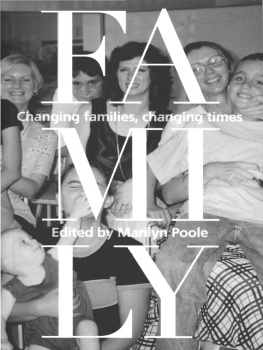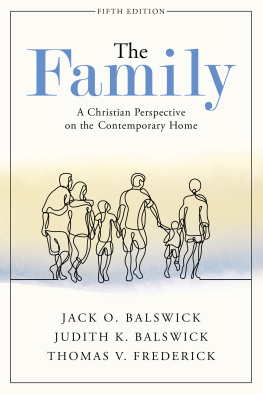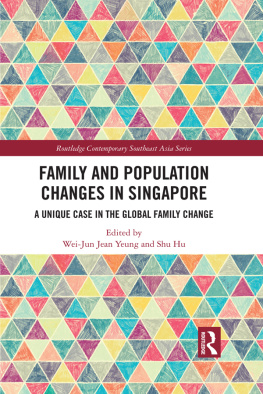Families in Todays World
Families in Todays World is an international textbook providing a quick introduction for students studying sociology of family in different countries around the world. It provides comprehensive coverage of the major topics in the sociology of family life.
Written in an easily accessible manner, the book opens with a chapter on defining family and family structures. It then moves on to discuss over a dozen major topics, from interaction and meaning in families to sexuality. David Cheal provides coverage of these topics by drawing on a variety of international material from countries around the world. Most of the studies focus on contemporary family life but Cheal also presents information on historical changes which have shaped family life as we know it today.
A prominent theme in the sociology of family today is diversity which makes this book an incredibly valuable teaching tool as it presents diversity in family patterns through thinking about family life globally. It is an essential resource for students of sociology, social policy, family studies and global issues.
David Cheal is a Professor of Sociology at the University of Winnipeg. His main areas of interest are Sociology Theory and the Sociology of the Family. He is the author of Sociology of Family Life (2002) and editor of Family: Critical Concepts (2003).
Families in Todays World
A comparative approach
David Cheal

First published 2008
by Routledge
2 Park Square, Milton Park, Abingdon, Oxon OX14 4RN
Simultaneously published in the USA and Canada
by Routledge
270 Madison Avenue, New York, NY 10016
Routledge is an imprint of the Taylor & Francis Group, an informa business
This edition published in the Taylor & Francis e-Library, 2008.
To purchase your own copy of this or any of Taylor & Francis or Routledges collection of thousands of eBooks please go to www.eBookstore.tandf.co.uk.
2008 David Cheal
All rights reserved. No part of this book may be reprinted or reproduced or utilised in any form or by any electronic, mechanical, or other means, now known or hereafter invented, including photocopying and recording, or in any information storage or retrieval system, without permission in writing from the publishers.
British Library Cataloguing in Publication Data
A catalogue record for this book is available from the British Library
Library of Congress Cataloging in Publication Data
Cheal, David J.
Families in todays world: a comparative approach|David Cheal
p.cm.
1. Family. 2. FamilyCross-cultural studies. I. Title.
HQ519.C44 2007
306.85dc 22 2007020405
ISBN 0-203-00721-2 Master e-book ISBN
ISBN 13: 978-0-415-35930-6 (pbk)
ISBN 13: 978-0-415-35931-3 (hbk)
ISBN 13: 978-0-203-00721-1(ebk)
ISBN 10: 0-415-35930--9 (pbk)
ISBN 10: 0-415-35931-7 (hbk)
ISBN 10: 0-203-00721-2 (ebk)
Preface
Families in Todays World is intended as an international textbook for students studying the sociology of the family in different countries. The key objective of this book is to cover the major topics in the sociology of the family revealed through a search of the literature. A second objective is to provide coverage of these topics by drawing on material from countries around the world. The book should be a valuable teaching tool because a prominent theme in the sociology of the family today is diversity, yet most family sociology textbooks study diversity only within national boundaries. Families in Todays World demonstrates diversity as a way of thinking about the family globally.
This book opens with a chapter on Defining Family and Family Structures. Problems in defining family are reviewed and different types of family are outlined. The dominance of the model of the nuclear family in earlier years is discussed, and described as the result of ideological assumptions about family life. Attention therefore shifts to describing social constructs of family life. It is concluded that because the concept of family refers to a wide range of diverse phenomena, it has no logical basis apart from the everyday usages of social actors. In the particular discourse of the social sciences, most of the categorizations of family life are types of family structures. The chapter then moves on to a description of family structures such as cohabitation, single-parent families, extended families and polygyny.
takes up the subject matter of interaction and meaning in families. It is through their interactions that family members give meaning to their lives together, and define the expectations that one has of the other. This can be a particular problem where partners are emotionally together but are physically apart. Physical togetherness is easiest where family members share a home, and the chapter discusses the history of the home as a form of social organization. Home and family are seen by most people in modern societies as standing in opposition to the meanings of employment in the market economy, but how to express the strength of these bonds in the face of a dominant market economy is a practical problem. One way of doing this is through the ritualization of family ties, which is discussed next. Gift giving is described as a particularly important family ritual.
Social divisions are the subject of . One of the most prominent divisions involves gender differences. Special attention is paid to married womens economic dependency, which is inextricably linked to their place in a gender division of labour. Womens economic dependency is still strongly influenced by the primacy given to domestic and childcare work. The chapter then turns to racial divisions, and reviews the special characteristics of African-American families. Economic differences between families are discussed next, with a special emphasis given to the effects of low income. The chapter concludes with a discussion of the relationship between family income and family characteristics. Some types of families do very well economically, whereas others fare very poorly.
focuses on social change. Major changes in family life are described, in both the Western societies and developing societies. If there is one master trend, it is that of individualization. Individuals have become differentiated from families and have acquired greater autonomy. Particular attention is paid to changing kinship ties in developing societies, and modernization theory is discussed. Divorce is discussed next, and the limitations of modernization theory are presented. Divorce rates have been changing everywhere, but they have not always been changing in the same direction. It is hypothesized that increases in womens employment and education in recent decades are responsible for several changes in family life, including increased divorce rates. Attention therefore shifts to a discussion of women and family change. Finally, the chapter ends with a section on the theory of the postmodern family.
The next chapter reviews the topic of demographic change. It opens by examining a common pattern of change in the Western societies and in some societies in Asia, namely falling birth rates. Reasons for declining fertility are analysed, and economic explanations and cultural explanations are presented. In economic explanations, the main focus is on the costs and benefits of having children. Cultural explanations of falling birth rates emphasize such factors as the declining influence of traditional norms, for example religious norms favouring large numbers of children. One of the consequences of declining fertility is population ageing, which is discussed next. This poses challenges for families and governments as they try to cope with the increasing numbers of elderly who are in need of support and care.






